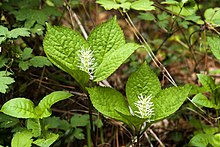
Back عطرورية Arabic كلورانطيه ARZ Chloranthaceae AST Chloranthaceae Azerbaijani Clorantàcies Catalan Chloranthaceae CEB Žlutokvětovité Czech Chloranthaceae German Klorantacoj Esperanto Chloranthaceae Spanish
| Chloranthaceae Temporal range:
| |
|---|---|

| |
| Sarcandra glabra | |

| |
| Chloranthus fortunei | |
| Scientific classification | |
| Kingdom: | Plantae |
| Clade: | Tracheophytes |
| Clade: | Angiosperms |
| Order: | Chloranthales R.Br.[2] |
| Family: | Chloranthaceae R.Br. ex Sims[2] |
| Genera | |
| |
Chloranthaceae /ˌklɔːrænˈθeɪʃiː/ is a family of flowering plants (angiosperms), the only family in the order Chloranthales.[2] It is not closely related to any other family of flowering plants, and is among the early-diverging lineages in the angiosperms. They are woody or weakly woody plants occurring in Southeast Asia, the Pacific, Madagascar, Central and South America, and the West Indies. The family consists of four extant genera, totalling about 77 known species according to Christenhusz and Byng in 2016.[3] Some species are used in traditional medicine. The type genus is Chloranthus. The fossil record of the family, mostly represented by pollen such as Clavatipollenites, extends back to the dawn of the history of flowering plants in the Early Cretaceous, and has been found on all continents.[4]
- ^ "Chloranthales". www.mobot.org. Retrieved 2023-07-20.
- ^ a b c Angiosperm Phylogeny Group III (2009). "An update of the Angiosperm Phylogeny Group classification for the orders and families of flowering plants: APG III". Botanical Journal of the Linnean Society. 161 (2): 105–121. doi:10.1111/j.1095-8339.2009.00996.x. hdl:10654/18083.
- ^ Christenhusz, M. J. M.; Byng, J. W. (2016). "The number of known plants species in the world and its annual increase". Phytotaxa. 261 (3): 201–217. doi:10.11646/phytotaxa.261.3.1.
- ^ Pipo, M.; Iglesias, Ari; Bodnar, Josefina (2020). "New vesselless angiosperm stem with a cambial variant from the Upper Cretaceous of Antarctica". Acta Palaeontologica Polonica. 65. doi:10.4202/app.00697.2019. hdl:11336/136234.
© MMXXIII Rich X Search. We shall prevail. All rights reserved. Rich X Search